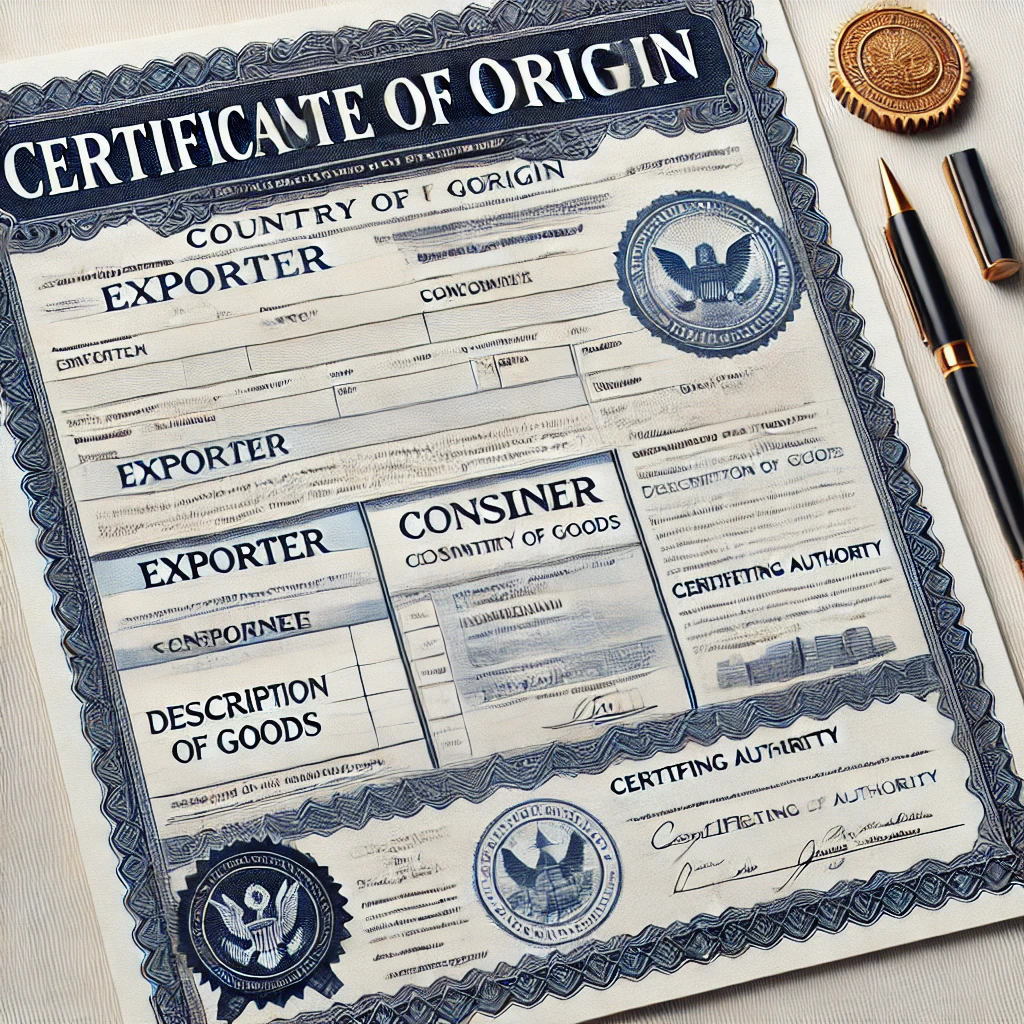Table of Contents
ToggleCertificate of Origin: Importance and Process
Introduction
In today’s globalized world, international trade plays a vital role in connecting businesses and economies. However, to facilitate smooth trade transactions, various documents are required to verify the origin, quality, and legitimacy of goods. One such crucial document is the Certificate of Origin (COO). This document acts as proof that the goods being exported or imported originate from a specific country, which can significantly impact tariffs, trade policies, and regulatory compliance.
In this article, we will explore the importance of the Certificate of Origin, its types, and the detailed process involved in obtaining one.

What is a Certificate of Origin?
A Certificate of Origin (COO) is an official document that certifies the country where a product was manufactured, produced, or processed. It is an essential requirement in international trade, as it determines the eligibility of goods for import tariffs, trade agreements, and customs clearance.
This certificate is typically issued by chambers of commerce, trade organizations, or government agencies and must comply with the regulations of the importing country. The COO helps prevent fraud, ensures fair trade practices, and enables importers to benefit from preferential tariffs under free trade agreements (FTAs).
Importance of the Certificate of Origin
The COO is important for several reasons, including:
1. Customs Clearance
Importing countries require the COO to verify the origin of goods before clearing them through customs. The document ensures that the correct duties and tariffs are applied based on the country of origin.
2. Determining Tariffs and Duties
Tariff rates vary depending on trade agreements between countries. Goods originating from a country with preferential trade agreements (e.g., NAFTA, ASEAN) may enjoy reduced or zero tariffs. The COO serves as proof to claim these benefits.
3. Trade Agreements and Preferential Treatment
Many countries have bilateral or multilateral trade agreements that provide duty-free or reduced tariffs for goods originating from member nations. The COO allows exporters to qualify for these preferential treatments.
4. Preventing Fraud and Misrepresentation
The COO ensures transparency and authenticity in international trade. Without it, businesses could falsely claim that their products originate from a country with lower tariffs or trade benefits.
5. Regulatory Compliance
Many importing countries have regulations requiring proof of origin for various reasons, including safety standards, embargoes, and quota restrictions. The COO helps businesses comply with these rules and avoid legal penalties.
6. Facilitating Smooth Trade Transactions
A valid COO helps expedite trade transactions by providing importers, customs authorities, and financial institutions with accurate documentation to process shipments efficiently.
Types of Certificates of Origin
There are two main types of Certificates of Origin, each serving a specific purpose:
1. Non-Preferential Certificate of Origin
This type of COO certifies the origin of goods but does not grant any preferential tariff treatment. It is required by countries that impose standard duties and taxes on imported goods.
2. Preferential Certificate of Origin
This COO certifies that the goods qualify for preferential tariff treatment under free trade agreements or special trade programs. Examples include:
NAFTA Certificate of Origin (now USMCA for North America)
EUR.1 Certificate (for trade with the European Union)
ASEAN-China Free Trade Area (ACFTA) Certificate of Origin
GSP Certificate of Origin (for goods eligible for Generalized System of Preferences benefits)
How to Obtain a Certificate of Origin
Obtaining a COO involves a series of steps that vary by country and industry. Below is a general outline of the process:
Step 1: Determine the Need for a COO
Exporters should first verify whether a COO is required for their shipment. This depends on the destination country’s import regulations and whether the goods qualify for preferential trade agreements.
Step 2: Gather Required Information
To apply for a COO, businesses need to provide specific details, including:
Name and address of the exporter
Name and address of the importer
Description of the goods
Tariff classification code
Country of origin of the goods
Export invoice details
Step 3: Identify the Issuing Authority
Most countries require the COO to be issued or certified by an authorized entity such as:
Local Chambers of Commerce
Government Trade Departments
Customs Authorities
Trade Associations
Step 4: Submit an Application
Exporters must submit a COO application along with supporting documents, such as invoices, packing lists, and manufacturing records. Some authorities allow online applications, while others require physical submission.
Step 5: Verification and Certification
The issuing authority reviews the application, verifies the authenticity of the information, and certifies the COO with an official stamp and signature.
Step 6: Delivery of the COO
Once certified, the COO is either physically handed to the exporter or electronically sent, depending on the issuing organization’s procedures.
Step 7: Submission to Importer and Customs Authorities
The exporter sends the COO to the importer, who then presents it to customs authorities in the importing country to clear the shipment and claim tariff benefits.
Electronic Certificates of Origin (eCO)
With the rise of digital transformation, many countries now accept Electronic Certificates of Origin (eCO). These are digitally signed and transmitted electronically, offering advantages such as:
Faster processing and approval
Reduced risk of document loss or fraud
Lower administrative costs
Easier access for customs authorities and businesses
Common Challenges and Solutions
While the COO is a vital document, exporters may face challenges in obtaining and using it. Some common issues include:
1. Incorrect Information
If the COO contains errors in the product description, HS code, or origin details, it may be rejected by customs. Solution: Double-check all information before submission.
2. Delays in Certification
Manual processing can cause delays, impacting shipment timelines. Solution: Apply in advance and use electronic certification where available.
3. Lack of Awareness
Some exporters may not be aware of COO requirements for specific markets. Solution: Stay informed about the destination country’s regulations and seek expert guidance.
Conclusion
The Certificate of Origin is a fundamental document in international trade, ensuring compliance, fair trade practices, and tariff benefits. Understanding its importance, types, and the process of obtaining one can help businesses streamline their export operations, reduce costs, and facilitate smooth cross-border transactions.
As trade regulations evolve, businesses should also explore electronic certificates of origin to enhance efficiency and security. By staying compliant and proactive, exporters can leverage the COO to their advantage, fostering stronger international trade relationships and expanding global market reach.
